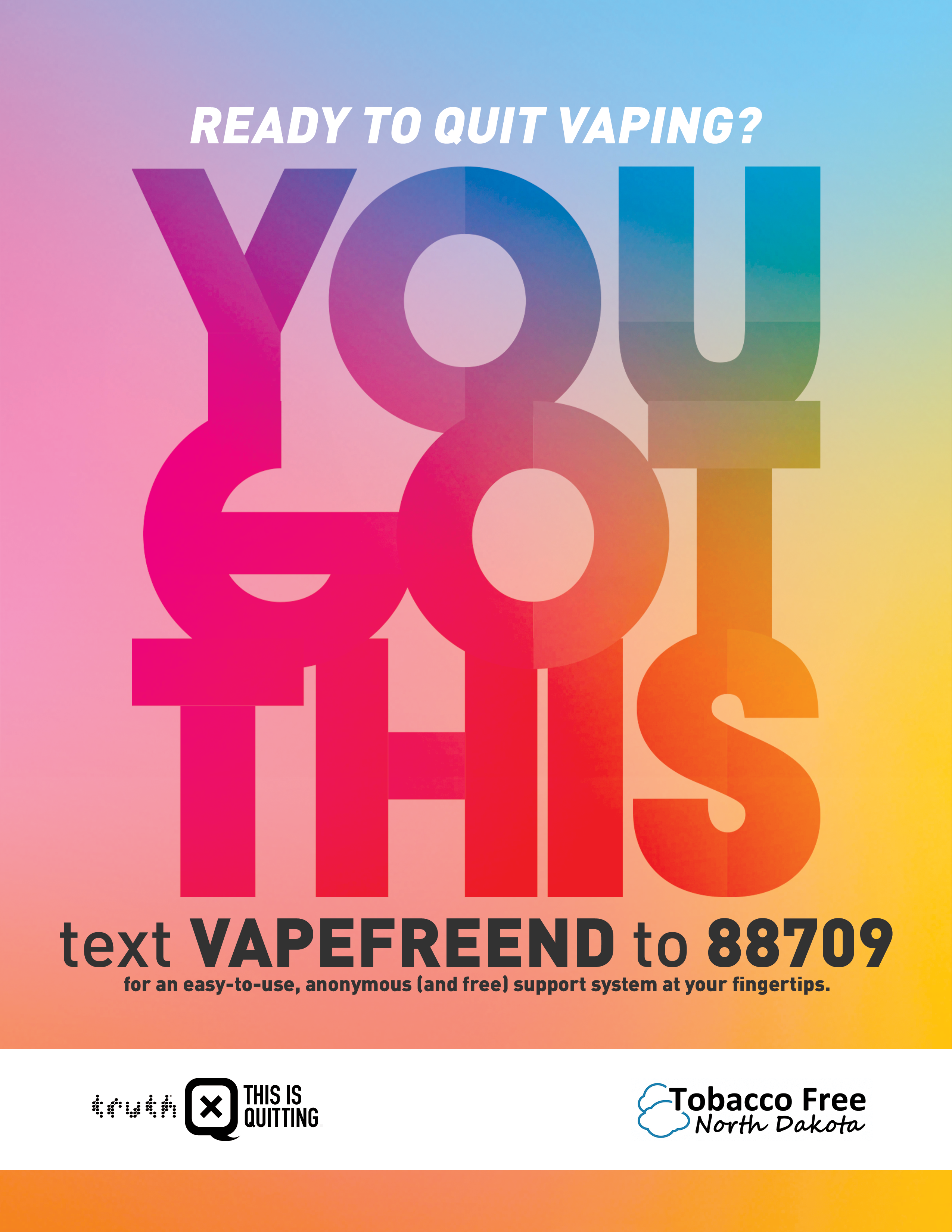
There’s plenty of ways to get involved with Tobacco Free North Dakota and our mission. Consider signing our support cards and resolutions.
What are TFND Support Cards?
TFND strongly believes in a 3-fold approach to tobacco control: raising the price of tobacco, funding a comprehensive tobacco control program and maintaining North Dakota’s very strong smoke-free air law. The cards below will be used to inform legislators that their constituents want smart tobacco policy! We also have resolutions of support for businesses to fill out that mimic the support cards. We’re asking all North Dakotans to fill out the three support cards and mail them back to TFND, P.O. Box 3237, Bismarck, ND 58502. We will then organize the cards and make sure your legislators see them. Anyone can fill them out!
Fillable TFND-Individual-Support-Card-for-Tobacco-Price-Increase
Fillable TFND-Individual-Support-Card-for-Fully-Funded-Program
Fillable TFND-Individual-Support-Card-for-SFAL
2024-2025 Comprehensive Program Funding Resolution
2024-2025 Tobacco Price Increase Resolution
2024-2025 Smoke-Free Air Law Resolution of Support
We also have state-specific data to paint a clear picture about what is happening in North Dakota
2023-25 State of Tobacco Control in North Dakota
2021-23 State of Tobacco Control in North Dakota
The tax for a pack of 20 cigarettes in North Dakota is 44 cents per pack, 49th in the country. Only Georgia and Missouri have lower tax rates. North Dakota hasn’t increased the tax on cigarettes since 1993.
Taxes on snuff, chewing tobacco, pipe tobacco and cigars are different than cigarettes. E-cigarettes are only subjected to sales tax. Raising the price of tobacco is one of the CDC’s best practices for statewide tobacco control programs. By the numbers, tobacco costs North Dakotans- whether they smoke or not.
- About 15 percent of adults in North Dakota smoke cigarettes
- North Dakota collected $47.5 million all tobacco taxes during the 2021-2023 biennium (ND Tax Commissioner annual statement of collections)
- The state pays $61.1 million each year in Medicaid costs directly related to tobacco use
- North Dakotans pay $379 million every year in tobacco-related healthcare costs
- Smoking-related productivity losses: $715 million a year
- Every household pays $970 in taxes directly related to smoking-related government costs
We’re working to increase the price of all tobacco products in a fair, responsible manner. In the 2019 legislative session, TFND strongly supported SB2355, which replaced the state’s different taxing levels of tobacco products with a uniform rate. The bill didn’t go through, however the legislature graciously decided to study the issue in the 2019-2020 interim period. We are continuing to work with legislators to make great policy for the state.
Lawmakers say they want to hear from constituents about whether you support a price increase. Fill out a Fillable TFND-Individual-Support-Card-for-Tobacco-Price-Increase or a 2024-2025 Tobacco Price Increase Resolution mail them back to Tobacco Free North Dakota, P.O. Box 3237, Bismarck, ND 58502 or email the completed electronic forms to info@tfnd.org.
MAKE YOUR VOICE HEARD TODAY!
Resources:
2019 Truth Initiative Tobacco Use in North Dakota
Reports on Cigarette+Tobacco Tax Collections in North Dakota
Raising the price of tobacco is a good start, but that move can only so much to help people quit. States need to have robust tobacco control programs. The CDC’s most recent recommendations came in a 2014. Full version can be found Here.
The CDC recommends North Dakota spends $9.8 million per year for a tobacco control program. The minimum recommended level for spending is $7 million per year. North Dakota currently spends about $7.1 million per year. An ideal program has 5 parts:
- State and Community Interventions
- Mass-Reach Communications
- Cessation Resources
- Surveillance and Evaluation
- Infrastructure and Administration
Fully funded programs are proven methods to help adults quit smoking and keep youth from ever starting. Research shows 9 in 10 cigarette users decide to start smoking before their 18th birthday according to the CDC. States with fully funded programs reduce smoking more than underfunded programs. TFND continues to work with legislators to find ways to increase funding for our state’s tobacco control program.
Want to get in touch with your legislator? Fill out a Fillable TFND-Individual-Support-Card-for-Fully-Funded-Program or a 2024-2025 Comprehensive Program Funding Resolution and send the completed form back to TFND, P.O. Box 3237, Bismarck, ND 58502 or to info@tfnd.org.
The third leg of our policy stool is having a strong smoke-free air law. North Dakota voters overwhelmingly approved the measure in the 2012 election, with the law going into effect on December 6, 2012. The text of the ND Century Code pertaining to the law can be found below, starting with 23-12-09:
The law prohibits the use of traditional and electronic smoking devices in any public place or place of employment.
The law does not restrict smoking in private residences (unless the residence is used as a childcare, adult day care, or health care facility subject to licensure by the Department of Human Services) or in areas not commonly accessible to the public that are part of an owner operated business having no employees other than the owner operator or outdoor places that are more than twenty (20) feet from entrances, exits, operable windows, air intakes and ventilation systems of an establishment in which smoking is prohibited.
North Dakota still wants this law!
Every single county voted in favor of the law. A 2016 survey showed 80 percent of North Dakotans still support the smoke-free air law. Now we want to hear from you! You can print and fill out a Fillable TFND-Individual-Support-Card-for-SFAL or a 2024-2025 Smoke-Free Air Law Resolution of Support and mail back to TFND, P.O. Box 3237, Bismarck, ND 58502, or send the completed electronic forms to info@tfnd.org
Below are other helpful links with more information about the Smoke-Free Air Law.
Smoke-free/Tobacco-free Schools in North Dakota
Smoke-free Law
Smoking is an addiction caused by nicotine. Nicotine’s effect on the brain is simple- it rewires the brain to crave more and more. A pack of cigarettes contains 20mg of nicotine. Many electronic products contain more anywhere from 20mg-50 mg of nicotine.
SWITCHING ISN’T QUITTING!
Vice Admiral Jerome Adams, the Surgeon General of the United States, issued a 700-page report early in 2020, stating the best practices for tobacco cessation were FDA-approved medication and counseling. Adams addressed e-cigarettes in the report saying:
“it is difficult to make generalizations about efficacy for cessation based on clinical trials involving a particular e-cigarette, and there is presently inadequate evidence to conclude that e-cigarettes, in general, increase smoking cessation.”
You can read the full report by clicking here
North Dakota State University’s Kelly Buettner-Schmidt has also done multiple studies proving the contents of e-liquid containers don’t match the labels. To read a summary of her latest piece, including a link to the full article, Ecig Not the Solution NPJ.
Where Do I Start?
The most important thing to know about quitting is that you are not alone. A 2015 CDC survey showed:
- 68 percent of current adult cigarette users wanted to stop
- 55 percent attempted a quit in the past 12 months
- 7 percent quit within 6-12 months
If you try to quit once and don’t succeed, KEEP TRYING! YOU CAN DO IT! Every attempt- successful or not- makes a tremendous difference and if you keep trying, you will be successful. Below are some additional links to local and national cessation resources.
Contacts:
- NDQuits
- Local Cessation Resources Across North Dakota
- Tips and Tricks from the CDC
- Become an Ex
- Smokefree.gov
- ALA – Freedom from Smoking Online
Options for Youth Trying to Quit
FDA-Approved Medications for Smoking Cessation
Smoke-free Savings Calculator: Use this handy link to calculate how much money can be saved by quitting!
THIS IS QUITTING
Text VAPEFREEND to 88709

On April 1, 2022, TFND launched a brand new text-to-quit cessation service for youth ages 13-24 who use vape products. The program, This Is Quitting, is a partnership with Truth Initiative to provide a free, easy to use, and anonymous service for those looking to quit vaping. All you needs to do is text VAPEFREEND to 88709 to get started.
It’s time to ditch vapes. Take back control of your health and your life.
Vaping Statistics
- 38.6 percent of ND High School students (grades 9-12) have tried vape products.
- 17.4 percent of ND Middle School students (grades 7-8) have tried vape products.
- Flavored products go hand-in-hand with youth use. According to Campaign for Tobacco Free Kids, 85% of youth e-cigarette users use flavored products, including fruit, candy/desserts/other sweets, mint and menthol.
- Nicotine dependence can alter the brain’s prefrontal cortex in people under the age of 25. A properly formed prefrontal cortex allows people to make rational decisions and control impulses.
Want to help get the word out? You can print these business cards or posters and share them around!
8.5×11 Orange Flier 1 with QR Code
8.5×11 Orange Flier 2 with QR Code
Government Studies/Reports:
-
- 2024 Surgeon General Report- Tobacco Related Health Disparities
- Tobacco Cessation and Medicaid Coverage in North Dakota 2021
- 2020 Surgeon General Report on Tobacco Cessation
- 2019 Tobacco Industry in Schools
- 2014 50th Anniversary Surgeon General’s Report on Smoking and Health
- 2014 Surgeon General’s Report on Smoking
- CDC 2014 Best Practice Guide
TFND Educational Webinars:
- How to Present for Youth- November 18, 2021
- Media Training- December 16, 2021
- Creating Sound Tobacco Policies- January 20,2022
- Cessation- March 24, 2022
- Coalition Building Part 1- April 21, 2022
- Coalition Building Part 2- May 19, 2022
- Connecting with Policymakers ft. ACS-CAN- July 21, 2022
- Quit Week Lessons Learned- August 24, 2022
- Quit Week Lessons Learned- September 28 2023
- Pharmacy Engagement- November 16 2023
- Campaign Planning for Local Initiatives- January 18 2024
- Partnering With Schools- February 22 2024
- Traditional vs Commercial Tobacco- April 25, 2024
- Quit Week 2024- May 9, 2024
- North Dakota Tobacco Use Trends and Data Sources- September 5, 2024
- TFND 2025 Legislative Priorities- October 24, 2024
- 2025 Legislative Recap- April 17, 2025
Economic Studies:
Other:
